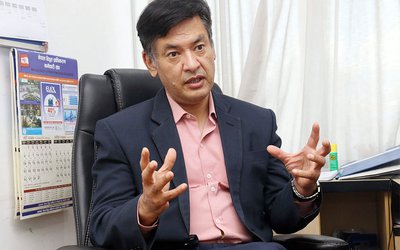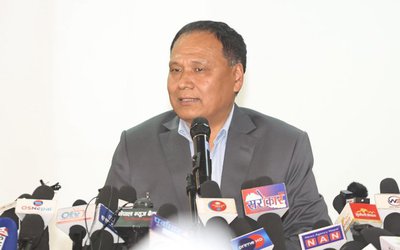
Nepal's hydropower generation has already been impacted by the drying of rivers, prolonged droughts, rising temperatures, rapid snow melting, and glacier retreat. This is exemplified by the 456 MW, the largest hydropower plant in Nepal, which highlights the imminent crisis caused by climate change and the potential loss and damage faced by the country. The shifting patterns of precipitation will not only vary between countries but also within nations.
During his recent address to a high-level delegation from the Asian Infrastructure Investment Bank (AIIB), Kul Man Ghising, the Managing Director of the Nepal Electricity Authority (NEA), emphasized the threat that climate change poses to Nepal's hydropower sector. Ghising pointed out that despite Nepal's contribution to greenhouse gas emissions being only 0.0027 percent, the impact is significant. He highlighted changes in precipitation patterns, glacier retreat, shifts in river flows, and an increase in extreme events such as flash floods and droughts as factors leading to decreased hydropower generation. Additionally, Ghising mentioned issues like sedimentation, rising temperatures, and challenges related to water availability and demand.

Not nominating a Nepalese participant for a high-level LDC meeting in Malawi, scheduled for next week, is causing Nepal to miss out on a significant opportunity. This decision comes at a time when the hydropower sector is already facing substantial losses, which are detrimental to the national economy and development.
The Finance Minister, Barsha Man Pun, has emphasized the importance of utilizing the available climate funds for Nepal's development. However, the Ministry of Forest and Environment is contradicting this by not sending any delegation to the conference where Nepal is supposed to present its position.
Environmentalist have expressed their frustration, stating that senior officials at the Ministry of Foreign and Environment lack understanding of international climate change issues and perspectives. They believe that separating the Ministry of Environment from the Ministry of Forest is necessary if Nepal intends to utilize the climate fund for its development.
The current capacity of the Ministry of Forest and Environment, which primarily focuses on forestry matters, is insufficient considering the potential damage to Nepal's infrastructure, including hydropower, caused by climate-induced disasters.
What is Loss and Damage?
Loss and damage pertain to the detrimental consequences of climate change that surpass the ability of affected communities to cope and adjust. It encompasses both tangible losses, such as infrastructure damage and loss of life, as well as intangible losses like cultural heritage and community cohesion.

Climate change remains a contentious issue, with developed and developing nations interpreting and addressing it in varying ways. Developed countries often perceive it as falling within the realm of adaptation measures, whereas developing nations view it as encompassing impacts that go beyond the limits of adaptation.
Article 8 of the Paris Agreement acknowledges the significance of preventing, minimizing, and addressing loss and damage associated with climate change, thereby emphasizing the global commitment to tackling this issue (Paris Agreement, Article 8(1)). While adaptation is considered urgent, financial support for adaptation efforts lags behind mitigation financing.
The concept gained prominence in international climate negotiations through the establishment of the Warsaw International Mechanism for Loss and Damage (WIM) in 2013.
Loss and Damage, which has become a prominent topic in recent climate change discussions, lacks an official definition. It generally refers to the adverse impacts of climate change that cannot be mitigated or adapted to.
COP28 was a significant event as it concluded the first global assessment of efforts to combat climate change under the Paris Agreement. The term is commonly used to describe the UN climate negotiations and the strategies discussed to address climate impacts.
The decision to establish a Loss and Damage Fund at COP27 in 2022 in response to appeals for financial assistance for climate-vulnerable nations has been reached. Nevertheless, the establishment of the Fund and the development of its governing regulations are still pending, resulting in ongoing discussions regarding the efficacy of such a financial mechanism.
Up to now, there has been no designated international funding set aside for loss and damage within the United Nations Framework. For many countries, especially those most at risk from the effects of climate change such as Nepal, obtaining financial support for climate-induced losses is a crucial matter of accountability.
Given that Nepal is already experiencing damage as a result of climate change, it is one of the eligible candidates to request assistance for damages caused by rainfall, drought, and rising temperatures.
Nepal’s Position
Nepal has been advocating for the agenda within the LDCs group since 2013. Dr. Buddhi Sagar Paudyal, the head of the Climate Change Management Division, highlighted Nepal's long-standing efforts on this issue. The changing precipitation patterns have had a significant impact on various sectors, with hydropower plants experiencing noticeable losses.
Upper Tamakoshi Hydropower Limited (UTKHPL) has faced penalties from the Nepal Electricity Authority (NEA) for the third consecutive year due to its inability to meet the energy delivery requirements outlined in the Power Purchase Agreement (PPA). The fluctuations in water discharge, beyond the control of UTKHPL, have resulted in unforeseen challenges due to the unexpected changes in precipitation patterns.

The reduced water discharge in the river has affected the energy production capacity of Nepal's largest hydropower plant during the dry season from February to May. If this trend persists, UTKHPL may be required to pay an annual sum of approximately Rs. 500 million. Studies indicate that water resources will be significantly impacted by climate change effects, particularly in terms of altered precipitation patterns affecting river discharge and hydropower generation.
The generation capacity of the 456 MW Upper Tamakoshi has been directly affected by the recent changes in precipitation patterns over the past three years. The decrease in winter rainfall from 2020 to 2023 has resulted in a significant decline in water discharge levels in major river systems, including the Tamakosi river.
As a consequence, the effects of climate change have had a significant impact on electricity generation. Currently, during the evening and morning peak periods, electricity generation can reach up to 300-456 MW for a duration of 3-4 hours, as water is accumulated throughout the day. However, due to the changing climate patterns, the water level in the Tamakosi River has decreased, leading to a decrease in electricity generation, as stated by Mohan Gautam, CEO of Upper Tamakoshi Hydropower Limited (UTKHPL) in an interview.
As Nepal’s river are drying due to increasing days of drought and rise of temperature, fast snow melting and retreating of glacier, Nepal’s hydropower generation has already hit by these phenomenon.
456 MW, largest hydropower, is an example to depict the looming crisis cause by climate change and Nepal’s position for loss and damage. Shifting precipitation patterns will vary widely not just from country to country, but also within nations.
At a time when climate induced disasters are going to damage Nepal’s many infrastructures including hydropower, Nepal has to go to claim for the loss. For this, the current capacity of Ministry of Forest, which is a specialized ministry of forest, is not adequate.
What about the state of Fund
The loss and damage fund has already received pledges amounting to $700 million globally. Now, it is crucial for Least Developed Countries (LDCs) like Nepal to participate in negotiations in order to access these funds. However, the Ministry of Forest and Environment in Nepal is yet to reach a decision on this matter.
If the current trend of altered winter precipitation patterns persists in the coming years, projects such as the 456 MW Upper Tamakoshi could face significant financial losses in terms of annual income. This could also lead to a decline in clean energy production, resulting in a greater reliance on fossil fuels.
The declining trend in river discharge may pose a hindrance to Nepal's objective of achieving zero emissions by 2045 through its NDC, which primarily focuses on hydropower projects.
Economic Loss
The generation of clean electricity as a substitute for fossil fuels is greatly affected by the economic losses caused by the decline in water levels. The reduction in electricity generation, along with the penalties incurred for not meeting energy delivery agreements, is also impacting profits and limiting resources for growth. Despite appearing insignificant, these consequences have far-reaching implications at a national level.

In his recent article published in Urjakhabar online, Prabal Adhikari, former Deputy Managing Director of Nepal Electricity Authority, emphasizes the urgent need for Nepal to address the issue of living in a state of uneaten poison, despite its negligible impact on climate change. Adhikari stresses the importance of raising this concern at various levels, including international, regional, and sub-regional conferences and meetings.
Adhikari also highlights that the effects of climate change are already evident in the mountains of Nepal, leading to adverse impacts on water resources and hydropower projects in the region.
The rise in temperature will result in a decrease in water volume, reducing the lifespan of the turbines connected to these projects and leading to higher operational costs. Additionally, the occurrence of floods during summer and droughts in winter poses a significant risk of not meeting the contracted energy requirements for electricity production.
“Given this situation, it is imperative for the government to reassess its existing policies in order to maintain private sector investment and participation. As a country highly vulnerable to climate change, Nepal must incorporate energy-friendly provisions into its laws and policies and take timely and practical actions to address these challenges,” writes Adhikari.
According to Adhikari, Nepal must now consider the implications of climate change when developing energy plans and establishing electricity laws and agreements. If these regulations and agreements are not adapted to address the global impact of climate change, they will soon become impractical.
“It is anticipated that climate change will have a greater impact on Nepal's hydropower projects in the future, leading to reduced electricity production due to extreme natural disasters like floods and droughts. This will result in increased operation and maintenance costs, heightened risks, and limited ability to raise electricity prices in the market,” said Adhikari.
As a result of climate change, only a fraction of the project's connected capacity will be generated during the dry season. Therefore, it is imperative to exclude the provision for royalty on the connected capacity in the proposed legislation by replicating the old law. Numerous water sources have disappeared, leading to significant alterations in the river's flow pattern.
“Nepal Electricity Authority is the only public body in Nepal that procures electricity generated by private entities. In recent times, a provision has been implemented to levy a nominal deviation fee in cases of insufficient energy production in hydropower projects with a capacity of up to 10 megawatts. Moreover, developers are not subject to penalties for failing to meet power supply requirements as specified in the contract due to reduced water flow,” Adhikari said.
In that case, even if the production is not delivered, according to the PPA, the promoter will have to pay 80 percent of the 40 percent i.e. 32 percent of the fine to the buyer, or if the supply is less than one-third of the energy agreed in the contract, the penalty for the non-delivered energy will be paid to the authority only.
Nepal's hydropower projects face significant risks in the future due to various factors such as changes in precipitation patterns, glacial retreat, rising temperatures, and the increasing frequency and intensity of extreme natural disasters caused by climate change.

Keshab Poudel
Poudel is the editor of New Spotlight Magazine.
- KUL MAN GHISING: Bowing Down To The People
- Apr 13, 2025
- POLITICAL VIOLENCE: Culture of Impunity
- Apr 11, 2025
- PM OLI MEETS PM MODI: No Progress
- Apr 09, 2025
- PM OLI’S THAILAND VISIT: Flip Flop
- Apr 08, 2025
- FM Dr. Deuba’s India Visit: Mission Aborted
- Mar 26, 2025















